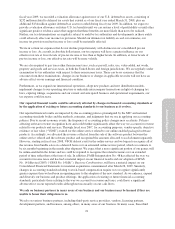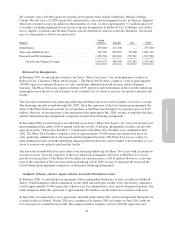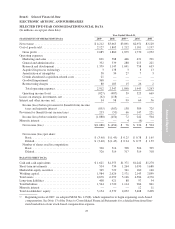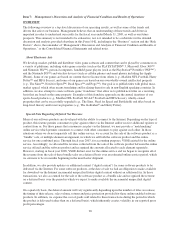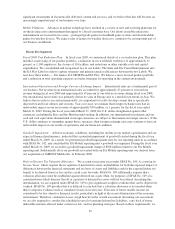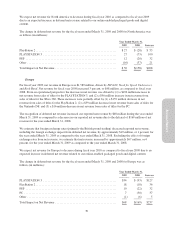Electronic Arts 2009 Annual Report Download - page 111
Download and view the complete annual report
Please find page 111 of the 2009 Electronic Arts annual report below. You can navigate through the pages in the report by either clicking on the pages listed below, or by using the keyword search tool below to find specific information within the annual report.
Annual Report
have recorded a valuation allowance against most of our U.S. deferred tax assets, consisting of $232 million
related to deferred tax assets that existed as of our fiscal year ended March 31, 2008, plus an additional $134
million against deferred tax assets recorded during fiscal year 2009. In addition, we expect to provide a valuation
allowance on future U.S. tax benefits until we can sustain a level of profitability or until other significant positive
evidence arises that suggests that these benefits are more likely than not to be realized.
CRITICAL ACCOUNTING POLICIES AND ESTIMATES
Our Consolidated Financial Statements have been prepared in accordance with accounting principles generally
accepted in the United States. The preparation of these Consolidated Financial Statements requires management
to make estimates and assumptions that affect the reported amounts of assets and liabilities, contingent assets and
liabilities, and revenue and expenses during the reporting periods. The policies discussed below are considered
by management to be critical because they are not only important to the portrayal of our financial condition and
results of operations, but also because application and interpretation of these policies requires both management
judgment and estimates of matters that are inherently uncertain and unknown. As a result, actual results may
differ materially from our estimates.
Revenue Recognition, Sales Returns, Allowances and Bad Debt Reserves
We derive revenue principally from sales of interactive software games designed for play on video game
consoles (such as the PLAYSTATION 3, Xbox 360 and Wii), PCs, handheld game players (such as the PSP and
Nintendo DS), and wireless devices (such as cellular phones and smart phones including the Apple iPhone). We
evaluate revenue recognition based on the criteria set forth in Statement of Position (“SOP”) 97-2, Software
Revenue Recognition, as amended by SOP 98-9, Modification of SOP 97-2, Software Revenue Recognition, With
Respect to Certain Transactions and Staff Accounting Bulletin (“SAB”) No. 104, Revenue Recognition.We
evaluate and recognize revenue when all four of the following criteria are met:
•Evidence of an arrangement. Evidence of an agreement with the customer that reflects the terms and
conditions to deliver products that must be present in order to recognize revenue.
•Delivery. Delivery is considered to occur when a product is shipped and the risk of loss and rewards of
ownership have been transferred to the customer. For online game services, delivery is considered to
occur as the service is provided. For digital downloads that do not have an online service component,
delivery is considered to occur generally when the download is made available.
•Fixed or determinable fee. If a portion of the arrangement fee is not fixed or determinable, we recognize
revenue as the amount becomes fixed or determinable.
•Collection is deemed probable. We conduct a credit review of each customer involved in a significant
transaction to determine the creditworthiness of the customer. Collection is deemed probable if we expect
the customer to be able to pay amounts under the arrangement as those amounts become due. If we
determine that collection is not probable, we recognize revenue when collection becomes probable
(generally upon cash collection).
Determining whether and when some of these criteria have been satisfied often involves assumptions and
management judgments that can have a significant impact on the timing and amount of revenue we report in each
period. For example, for multiple element arrangements, we must make assumptions and judgments in order to
(1) determine whether and when each element has been delivered, (2) determine whether undelivered products or
services are essential to the functionality of the delivered products and services, (3) determine whether VSOE
exists for each undelivered element, and (4) allocate the total price among the various elements we must deliver.
Changes to any of these assumptions or management judgments, or changes to the elements in a software
arrangement, could cause a material increase or decrease in the amount of revenue that we report in a particular
period. For example, in connection with some of our packaged goods product sales, we offer an online service
without an additional fee. Prior to fiscal year 2008, we were able to determine VSOE for the online service to be
delivered; therefore, we were able to allocate the total price received from the combined product and online
service sale between these two elements and recognize the related revenue separately. However, starting in fiscal
31


